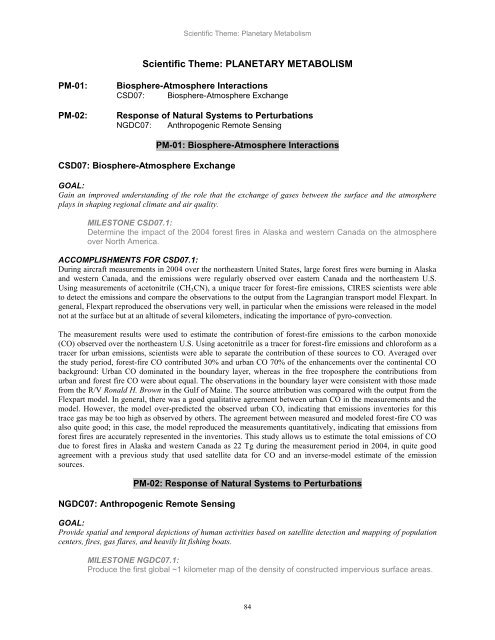Scientific Theme: Advanced Modeling and Observing Systems
Scientific Theme: Advanced Modeling and Observing Systems
Scientific Theme: Advanced Modeling and Observing Systems
Create successful ePaper yourself
Turn your PDF publications into a flip-book with our unique Google optimized e-Paper software.
<strong>Scientific</strong> <strong>Theme</strong>: Planetary Metabolism<br />
<strong>Scientific</strong> <strong>Theme</strong>: PLANETARY METABOLISM<br />
PM-01: Biosphere-Atmosphere Interactions<br />
CSD07: Biosphere-Atmosphere Exchange<br />
PM-02: Response of Natural <strong>Systems</strong> to Perturbations<br />
NGDC07: Anthropogenic Remote Sensing<br />
CSD07: Biosphere-Atmosphere Exchange<br />
PM-01: Biosphere-Atmosphere Interactions<br />
GOAL:<br />
Gain an improved underst<strong>and</strong>ing of the role that the exchange of gases between the surface <strong>and</strong> the atmosphere<br />
plays in shaping regional climate <strong>and</strong> air quality.<br />
MILESTONE CSD07.1:<br />
Determine the impact of the 2004 forest fires in Alaska <strong>and</strong> western Canada on the atmosphere<br />
over North America.<br />
ACCOMPLISHMENTS FOR CSD07.1:<br />
During aircraft measurements in 2004 over the northeastern United States, large forest fires were burning in Alaska<br />
<strong>and</strong> western Canada, <strong>and</strong> the emissions were regularly observed over eastern Canada <strong>and</strong> the northeastern U.S.<br />
Using measurements of acetonitrile (CH3CN), a unique tracer for forest-fire emissions, CIRES scientists were able<br />
to detect the emissions <strong>and</strong> compare the observations to the output from the Lagrangian transport model Flexpart. In<br />
general, Flexpart reproduced the observations very well, in particular when the emissions were released in the model<br />
not at the surface but at an altitude of several kilometers, indicating the importance of pyro-convection.<br />
The measurement results were used to estimate the contribution of forest-fire emissions to the carbon monoxide<br />
(CO) observed over the northeastern U.S. Using acetonitrile as a tracer for forest-fire emissions <strong>and</strong> chloroform as a<br />
tracer for urban emissions, scientists were able to separate the contribution of these sources to CO. Averaged over<br />
the study period, forest-fire CO contributed 30% <strong>and</strong> urban CO 70% of the enhancements over the continental CO<br />
background: Urban CO dominated in the boundary layer, whereas in the free troposphere the contributions from<br />
urban <strong>and</strong> forest fire CO were about equal. The observations in the boundary layer were consistent with those made<br />
from the R/V Ronald H. Brown in the Gulf of Maine. The source attribution was compared with the output from the<br />
Flexpart model. In general, there was a good qualitative agreement between urban CO in the measurements <strong>and</strong> the<br />
model. However, the model over-predicted the observed urban CO, indicating that emissions inventories for this<br />
trace gas may be too high as observed by others. The agreement between measured <strong>and</strong> modeled forest-fire CO was<br />
also quite good; in this case, the model reproduced the measurements quantitatively, indicating that emissions from<br />
forest fires are accurately represented in the inventories. This study allows us to estimate the total emissions of CO<br />
due to forest fires in Alaska <strong>and</strong> western Canada as 22 Tg during the measurement period in 2004, in quite good<br />
agreement with a previous study that used satellite data for CO <strong>and</strong> an inverse-model estimate of the emission<br />
sources.<br />
PM-02: Response of Natural <strong>Systems</strong> to Perturbations<br />
NGDC07: Anthropogenic Remote Sensing<br />
GOAL:<br />
Provide spatial <strong>and</strong> temporal depictions of human activities based on satellite detection <strong>and</strong> mapping of population<br />
centers, fires, gas flares, <strong>and</strong> heavily lit fishing boats.<br />
MILESTONE NGDC07.1:<br />
Produce the first global ~1 kilometer map of the density of constructed impervious surface areas.<br />
84
















